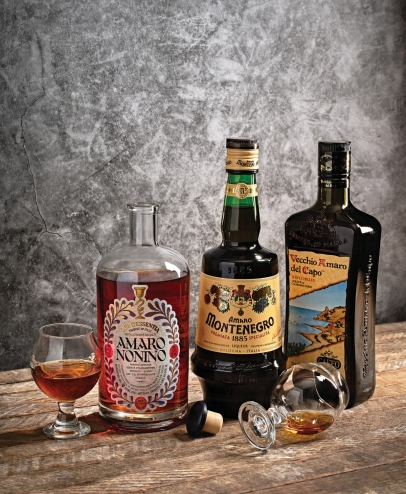That's Amaro!
The bittersweet herbal Italian liqueur is a versatile spirit that can be enjoyed on its own, mixed in cocktails or paired with food.
AMARI (the plural of amaro, the Italian word for bitter) are as varied as Italian cuisine. There are hundreds of versions of this bittersweet herbal Italian liqueur. It’s used in a variety of ways, including as an aperitif, a digestif, a mixer for cocktails and an accompaniment to food.
While some versions are quite bitter, there are also many sweet styles as well. The first amari were made by monks in the 13th century. In the 1800s commercial producers began selling and promoting the digestive and healing properties the monks were so very familiar with.
Unlike Italian wine, there are no rules regulating the creation of amari. They are made by infusing a base of alcohol—usually a neutral spirit, like grape brandy or wine—with botanical ingredients such as herbs, citrus peels, roots, spices and flowers. Exact recipes are fiercely guarded secrets and are passed down for generations.
The most famous ones are Campari and Aperol, but we’ll focus on a few of the lesser-known versions.
Brands available locally
Montenegro
(46 PROOF)
A lighter-style amaro, it was invented in 1885. This amaro is composed of 40 botanicals including baking spices, sweet and bitter oranges, artemisia, marjoram, oregano and coriander seeds. This plethora of ingredients facilitates both the creation of delectable cocktails featuring tequila and mezcal, and when enjoyed on the rocks it’s the type of spirit that will keep you coming back for more. It’s known as “the beginner’s amaro.”
Vecchio Amaro Del Capo
(70 PROOF)
With a prominent orange profile, it’s easy-drinking and lighter than many amari. It was created in 1915 by Giuseppe Caffo in Calabria with a proprietary recipe of 29 ingredients.
Amaro Nonino Quintessentia
(70 PROOF)
Originally made from a base of grappa (grape brandy), this is one of the sweeter amari. In 1933 third-generation distiller Antonio Nonino began infusing it with herbs from the mountains of Friuli in northern Italy. Now made using a grape distillate from the entire grape, this amaro is herbaceous and citrusy.
Amaro dell’Etna
(58 PROOF)
This luscious Sicilian amaro is produced using the original 1901 recipe of 26 ingredients that grow at the base of the namesake Mount Etna volcano. Two of those ingredients are bitter orange and spicy rhubarb. It’s heavier and spicier than many of its fellow amari.
Amaro Lucano
(56 PROOF)
Made in Basilicata, this example was created in 1894 by Pasquale Vena, a pastry chef who blended more than 30 herbs to create his rendition of this herbal liqueur. It’s on the bitter side of bittersweet, making it an excellent mixer for cocktails.
Averna
(58 PROOF)
This sweet amaro was the first licensed spirit of Sicily. In 1868, a monk from the local monastery Saint Spirito’s Abbey gave his secret recipe to textile merchant Don Salvatore Averna. The “sacred” 60-ingredient recipe has been passed down for more than 150 years. It’s on the sweeter edge of the spectrum and makes for a delectable digestif.
Fernet-Branca
(78 PROOF)
Intense, minty and far from sweet, this amaro is frequently used as a mixer in cocktails. Originally formulated in 1845 in Milan, it was not originally intended for imbibing for pleasure—it was marketed as a cure for fever, cholera and even worms. Yes, the type of worms that can live in your stomach!
Amari are increasingly popular here in the United States. As is the case with many beverage trends, bartenders on the East and West Coast have become enamored with amari. Americans are increasingly looking for “the next best thing” and have embraced amari as a unique addition to their beverage repertoire. While relatively recent, its popularity continues to grow both as a flexible cocktail component and as a traditional digestif. The range of aromas and flavors is both deep and broad. Expand your beverage horizon and try a few soon. Salute!
Michael Schafer likes to say he “edu-tains” about wine and spirits. Find him at TheWineCounselor.com.





